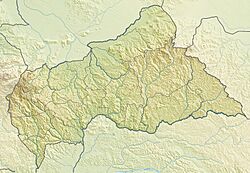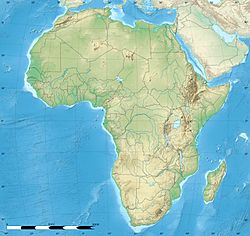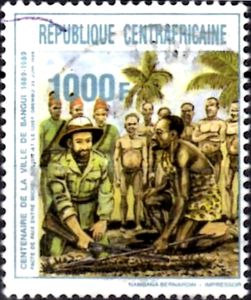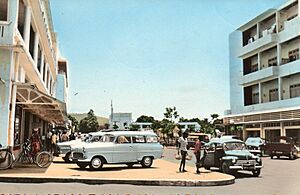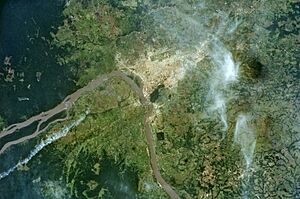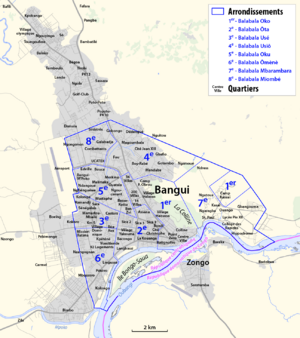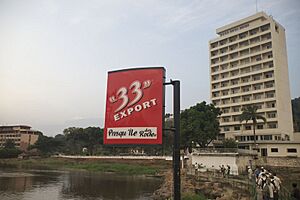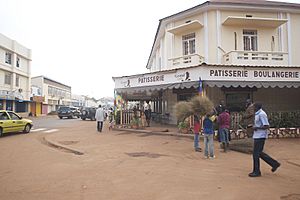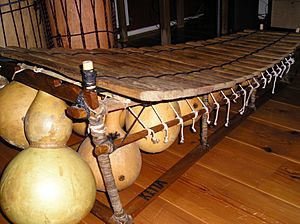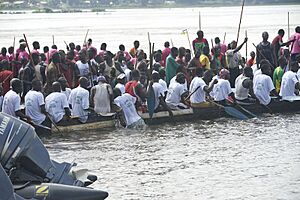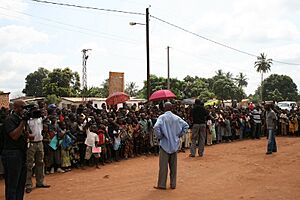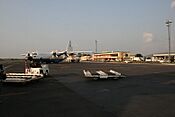Bangui facts for kids
Quick facts for kids
Bangui
Bangî
|
|
|---|---|
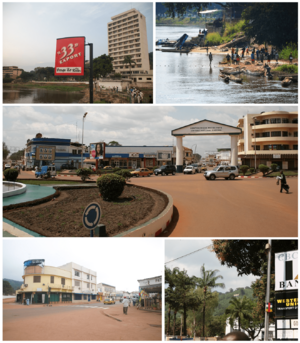
From left to right, top to bottom: Oubangui Hotel, shores of Bangui, Bangui Shopping District, pedestrian crossing, view of a street
|
|
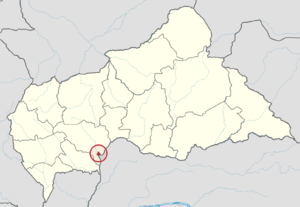
Bangui
|
|
| Country | |
| Prefecture | Bangui |
| Founded | 26 June 1889 |
| Area | |
| • Total | 67 km2 (26 sq mi) |
| Elevation | 369 m (1,211 ft) |
| Population
(2021)
|
|
| • Total | 812,407 |
| • Density | 12,130/km2 (31,400/sq mi) |
| Time zone | UTC+01:00 (West Africa Time) |
| • Summer (DST) | (Not Observed) |
| HDI | 0.420 (1st) |
Bangui (pronounced ban-gee) is the capital and largest city of the Central African Republic. It was started as a French outpost in 1889. The city is named after its location on the northern bank of the Ubangi River. The river itself was named after the "rapids" nearby, which marked the end of where boats could travel from Brazzaville. Most people in the Central African Republic live in the western parts of the country, including Bangui and the areas around it.
Since December 2020, Bangui has been part of the Bangui Prefecture. In 2020, it was estimated to have a population of 889,231 people.
Bangui is divided into eight city districts. It also has 16 groups and 205 neighborhoods. As the capital, Bangui is a key center for government, trade, and business. The country's National Assembly, government buildings, banks, and foreign embassies are all found here. Bangui makes things like textiles, food products, beer, shoes, and soap. The city is also home to the University of Bangui, which opened in 1970. The Bangui M'Poko International Airport serves the city.
Contents
History of Bangui
Archaeological studies around Bangui have found at least 26 old Iron Age sites. These sites contain many metal tools and objects. They help us understand the history of the city before Europeans arrived. These archaeological sites were added to the UNESCO World Heritage Tentative List in 2006. The site closest to Bangui is Pendere-Sengue, about 800 meters from Independence Avenue. Here, experts have found thousands of ceramic pieces, iron tools, pottery, and a large iron spatula. These findings might be from as far back as the ninth century BC.
The modern city of Bangui was founded on June 26, 1889, by Michel Dolisie and Alfred Uzac. It was part of what was then the upper French Congo. The first site was 10 kilometers south of the Ubangi rapids. The area was first called Upper Ubangi, then the separate colony of Ubangi-Shari. The first capitals of these areas were further upstream. However, the rapids at Bangui stopped direct river travel. This made Bangui grow in importance. In 1906, it became the new headquarters for the French government. Bangui remained an important military and government center during World War II, under both Vichy and Free French control.

The colony of Ubangi-Shari became self-governing in 1958 as the Central African Republic. It gained full independence from France in 1960. In 1970, President Jean-Bédel Bokassa opened the University of Bangui. He also started the national airline, Air Centrafrique, and ordered two new luxury hotels to be built in Bangui. Relations with France became difficult because Bokassa spent a lot of money. By 1975, Bangui had a population of 300,723 people.
In March 1981, there was a lot of unrest in Bangui after elections. France helped remove Bokassa from power and replaced him with David Dacko. Bokassa later returned to Bangui in 1986. He was put on trial and sentenced to prison. General André Kolingba then took control in 1981. He tried to fight corruption and manage the country's money. However, by the mid-1980s, the country's economy was in trouble.
Under pressure from international groups, Kolingba began to bring back democracy in 1991. Elections were held in 1993 and 1994. Ange-Félix Patassé was elected president. Since he was from northern CAR, a group from the south started a rebellion in 1996.
In May 1996, about 200 soldiers rebelled in Bangui. They demanded higher pay and for President Patassé to step down. The soldiers caused a lot of damage and harm. French troops in the country helped stop the rebellion. In early 1997, President Patassé announced a new government that included different groups. They signed the Bangui Agreements to help bring peace and improve the economy. Later that year, another revolt broke out.
Because of frequent political problems, Bangui was considered a very unsafe city in 1996. On October 25, 2002, General François Bozizé's forces attacked several towns and then Bangui itself. General Bozizé's troops fought in the city. Peacekeeping forces could not stop the fighting. Bozizé's troops took over the government, and Patassé had to leave the country. Bozizé seized power and suspended the country's rules. A temporary government was set up, but distrust continued.
2013 Rebellion
In late 2012, a group called Séléka rebelled against Bozizé's rule and entered Bangui. They captured important towns and were close to taking Damara, the last town before Bangui. France and the US did not support Bozizé. Neighboring countries sent forces to help.
In January 2013, the rebels stopped fighting, hoping for a peaceful solution. After a ceasefire and an agreement to share power, Séléka and Bozizé agreed to release rebel prisoners and remove foreign troops. The agreement allowed Bozizé to finish his term and include Séléka members in a new government. New elections were planned for 2016. However, the agreement was not followed. The rebels captured Bangui on March 23, 2013, forcing Bozizé to flee.
By early January 2014, about 500,000 people had left their homes in Bangui. This was almost half of the city's population.
Geography and Climate

Bangui is located near the country's southern border. It sits on the northern banks of the Ubangi River, just below some rapids that make it hard for large ships to travel further upstream. It is the only major city on the river and covers an area of 67 square kilometers. The Ubangi River is navigable and flows sharply south below Bangui. It connects to the Congo River as its main northern branch. The Ubangi River forms the border between the Central African Republic and the Democratic Republic of the Congo. The town of Zongo in Congo is right across the river from Bangui. The river flows to the east of downtown Bangui. During the rainy season, the river's water level is three times higher than at other times of the year. In the 1970s, the city was also known as La Coquette, meaning "the beautiful city."
Near the river, the city center has a large triumphal arch and the presidential palace. There is also a central market. About 5 kilometers further north, the main residential area has the largest market and most of the nightlife. Many people in the suburbs live in houses called Kodros, which are made of mud bricks with thatched roofs.
The Bangui Magnetic Anomaly is one of the Earth's largest magnetic features in its crust. It is the biggest in Africa, centered in Bangui. It looks like a huge oval, 700 km by 1000 km. Its center is at 6 degrees north and 18 degrees east. It has three parts: northern, southern, and central. The magnetic equator passes through its center. Even though it is well-known, scientists do not fully understand how it formed.
The Central African Republic is just north of the Equator. Daily temperatures usually reach at least 30°C. Bangui, being close to the Equator in the south, is slightly hotter and wetter than northern areas. It has a tropical savanna climate with dry winters. The warm season is from late January to mid-March. The cooler season is from late June to late August, when rain often comes with thunderstorms. The city is surrounded by thick tropical rainforests along the river banks. Some of its neighborhoods are in low areas. They often flood during heavy rains. For example, in June and July 2009, 11,000 people lost their homes due to flooding.
| Climate data for Bangui (Bangui M'poko International Airport) 1991–2020 | |||||||||||||
|---|---|---|---|---|---|---|---|---|---|---|---|---|---|
| Month | Jan | Feb | Mar | Apr | May | Jun | Jul | Aug | Sep | Oct | Nov | Dec | Year |
| Mean daily maximum °C (°F) | 33.8 (92.8) |
35.1 (95.2) |
34.7 (94.5) |
33.3 (91.9) |
32.4 (90.3) |
31.1 (88.0) |
30.4 (86.7) |
30.5 (86.9) |
31.3 (88.3) |
31.2 (88.2) |
32.1 (89.8) |
32.9 (91.2) |
32.4 (90.3) |
| Daily mean °C (°F) | 25.2 (77.4) |
26.9 (80.4) |
27.6 (81.7) |
27.1 (80.8) |
26.4 (79.5) |
25.5 (77.9) |
25.0 (77.0) |
25.1 (77.2) |
25.1 (77.2) |
25.0 (77.0) |
25.4 (77.7) |
25.2 (77.4) |
25.8 (78.4) |
| Mean daily minimum °C (°F) | 18.2 (64.8) |
20.8 (69.4) |
22.6 (72.7) |
22.5 (72.5) |
22.1 (71.8) |
21.6 (70.9) |
21.3 (70.3) |
21.3 (70.3) |
21.2 (70.2) |
21.2 (70.2) |
20.9 (69.6) |
19.1 (66.4) |
21.1 (70.0) |
| Average precipitation mm (inches) | 11.1 (0.44) |
43.3 (1.70) |
98.3 (3.87) |
117.6 (4.63) |
151.7 (5.97) |
160.8 (6.33) |
196.8 (7.75) |
218.3 (8.59) |
175.7 (6.92) |
198.4 (7.81) |
68.5 (2.70) |
18.0 (0.71) |
1,458.4 (57.42) |
| Average precipitation days (≥ 1.0 mm) | 1 | 3 | 7 | 8 | 9 | 10 | 12 | 12 | 11 | 12 | 7 | 2 | 94 |
| Average relative humidity (%) (daily average) | 62.8 | 62.1 | 67.9 | 73.3 | 76.2 | 78.2 | 80.0 | 79.8 | 78.3 | 78.5 | 74.7 | 68.4 | 73.4 |
| Mean monthly sunshine hours | 221 | 208 | 207 | 195 | 191 | 184 | 162 | 160 | 161 | 167 | 198 | 237 | 2,291 |
| Source: NOAA | |||||||||||||
People of Bangui
| Historical population | ||
|---|---|---|
| Year | Pop. | ±% |
| 1950 | 42,000 | — |
| 1951 | 47,000 | +11.9% |
| 1960 | 94,000 | +100.0% |
| 1970 | 204,000 | +117.0% |
| 1975 | 279,800 | +37.2% |
| 1988 | 427,435 | +52.8% |
| 1994 | 524,000 | +22.6% |
| 2001 | 652,000 | +24.4% |
| 2020 | 889,000 | +36.3% |
| 2021 | 910,000 | +2.4% |
| 2022 | 933,000 | +2.5% |
After the Central African Republic became independent in 1960, Bangui grew quickly. Its population increased from 279,800 in 1975 to 933,000 in 2022. Besides the local people, Bangui is also home to smaller groups of Greek, Portuguese, and Yemeni traders. There is also a small community of French people. The city also has diamond traders from western Africa and Chad, traders from many African countries, and refugees from the Democratic Republic of the Congo and Nigeria.
The official languages of the country are French and Sango. Sango, originally from the Ubangi River region, is spoken by 90% of the population. Other languages spoken include Baya, Banda, Ngbaka, Sara, Mbum, Kare, and Mandjia. Christian missionaries simplified Sango, and it is still widely used today.
Economy
Bangui is a key center for government, trade, and business. During World War II, the country became richer as it exported more rubber, cotton, coffee, uranium, and diamonds. After the war, local people started working in the government. This helped develop the country's infrastructure and increased trade.
During David Dacko's time as president (1960-1966), diamond production greatly increased. This happened when a law allowed local citizens to dig for diamonds, ending the monopoly of French companies. Dacko set up a diamond cutting factory in Bangui, and diamonds became the country's main export. However, by the end of his time in office, there were problems with money and unpaid workers, leading to unrest.
Bangui also became an important center for social and cultural activities. However, political problems, corruption, and the rule of President Bokassa led to economic difficulties in the 1970s. This was made worse by a drop in international prices for the country's main exports. This caused poverty and conflict. Many refugees also came from troubled neighboring countries.
Bangui got its first bank in 1946. Arab sellers were very important in the city, and it was historically a major center for ivory trading. Bangui manufactures include textiles, food products, beer, shoes, and soap. The main exports are cotton, rubber, timber, coffee, and sisal. Because of ongoing conflicts, unemployment in the city was around 23% in 2001. Ngaragba Central Prison, the national prison for men, is located in Bangui.
Landmarks
The old part of Bangui still has its colonial town plan. It features wide streets that lead to a central market square. Interesting places in Bangui include the Boganda Museum, Bangui Zoo, and the Presidential Palace. Notre-Dame Cathedral is the main church for the Roman Catholic Archdiocese of Bangui. The Boganda Museum (Musée de Boganda) shows traditional musical instruments, weapons, old hunting tools, pottery, and religious items. It also has a collection of bark cloth.
There are several hotels that meet international standards. The Ledger Plaza Bangui on the edge of the city has an outdoor swimming pool and tennis court. The National Hotel opened in 1970 with 30 rooms. Other notable hotels include the Golf Palace Hotel, the Hotel du Centre, JM Residence, the Oubangui Hotel (opened in 1985), and Hotel Somba.
Culture
Customs
Polygamy (where a man can have more than one wife) is accepted among men.
When someone passes away in Bangui, a person from their village attends the funeral. This person is responsible for guiding the spirit of the deceased back home. This is so the deceased can bring justice and show the family's power. The representative also takes a small amount of dust from the grave back to the village. They give it to the village's medicine man to find out why the person died.
Most holidays in Bangui are Christian and Muslim festivals. They are celebrated like in other parts of the world. National holidays include Independence Day and the birthdays of national heroes.
Cuisine
The food of CAR is called Centrafrican. The main foods in Bangui include cassava, rice, squash, pumpkins, and plantains. These are usually served with a sauce and grilled meat. Okra or gombo is a popular vegetable. Peanuts and peanut butter are widely used. Wild game is popular, as are fish dishes like maboké and soussou. Manioc flour is used to make fufu.
There are three types of restaurants in Bangui. Some offer foreign food, like French or Lebanese dishes. There are also many African restaurants, such as "Madame M'boka," which is a favorite among locals. Many bars and street food stalls add to Bangui's food scene. Local alcoholic drinks include brewed beer, palm wine, and banana wine. Non-alcoholic drinks include ginger beer.
Art
Bangui's artisans' market sells traditional art from different parts of the country. Handicrafts include woven mats and baskets, simple wooden tools, carved stools, pottery, musical instruments, and leather goods. The balafon, which is like a xylophone, is made from animal horns. Artists also create unique designs using butterfly wings glued onto paper. They carve animals and human figures from ebony and other hardwoods found in the tropical region. A crafts center in Bangui trains about 100 students in making art from leather, ivory, and ebony.
Music
Bangui has a rich music tradition and showcases the country's music. Its musicians also perform in many countries abroad. Bangui's bands were influenced by Zokela in the 1980s. This new music is based on dance bands that use electronic sounds with Congolese music. The music is rhythmic and blends with Congolese rumba (soukous), which was influenced by son cubano, cha-cha-cha, and merengue. Popular Central African music groups and dance bands that perform in the city include Musiki, Zokela, Makembe, Cool Stars, Cannon Stars, and Super Stars.
Sports
The most popular sport in Bangui is basketball. Bangui hosted the FIBA Africa Championship 1974. The Central African Republic's national basketball team won one of its two continental titles there. Football (soccer) is also popular. Both men and women from Bangui and across the country have taken part in the Olympic Games since 1968. They also compete in many international events. Locals also organize boat races with hundreds of participants on the Ubangi River, which is a big attraction.
Education
The French education system is used, and French is the language of teaching. However, the Sango language is also encouraged in schools. A large number of people in Bangui can read and write. School is required for children aged 6 to 14.
Bangui is home to the University of Bangui. It was founded in 1969 and started operating in 1970. It is a public university that provides non-agricultural education in the Central African Republic. Since 1981, the University Library has been in a separate building. It holds collections for science, literature, and law. The university's medical school has its own library.
Other educational places include the National School of Arts and the Central School of Agriculture. There are also many religious and technical schools.
A school in the eastern part of the city, Lycée Charles de Gaulle, was started by the French. It is named after President of France Charles de Gaulle. Several famous Africans, including writers like Calixthe Beyala, have studied in the city. Beyala studied at the Lycée des Rapides.
Places of Worship
Among the places of worship, most are Christian churches and temples. These include the Roman Catholic Archdiocese of Bangui (Catholic Church), the Evangelical Lutheran Church of the Central African Republic (Lutheran World Federation), and the Evangelical Baptist Church of the Central African Republic (Baptist World Alliance). There are also Muslim mosques.
Transport
Bangui is the main transport hub of the Central African Republic. As of 1999, eight roads connected the city to other main towns in the country, Cameroon, Chad, and South Sudan. Only the toll roads are paved. During the rainy season (March to November), some roads can become impassable. The road network in the city starts from the Palace de la Republique.
River ferries travel from the river port at Bangui to Brazzaville and Zongo. The river can be used for navigation most of the year between Bangui and Brazzaville. From Brazzaville, goods are transported by train to Pointe-Noire, Congo's Atlantic port. The river port handles most of the country's international trade. It can handle 350,000 tons of cargo. It has 350 meters of wharfs and 24,000 square meters of storage space.
The first airstrip in Bangui was built between 1920 and 1925. Bangui M'Poko International Airport is located on 600 hectares of cleared land. It is about 7 kilometers north of the old town, between Koudoukou Avenue and the University of Bangui.
Healthcare
A general hospital is located on the eastern side of the city. Modern health care facilities only exist in Bangui, but they are basic. Wealthier citizens use private clinics. The risk of getting malaria in Bangui is much higher than in the rest of the country.
In October 1985, a meeting of public health officials was held in Bangui. Representatives from the Centers for Disease Control and the World Health Organization attended. This meeting created a way to define AIDS, which became known as the Bangui definition for AIDS.
Media
Several periodicals and three daily newspapers are published in Bangui. E le Songo, the country's first newspaper, started in 1982. The other main newspapers are Le Novateur, Le Citoyen, and L'Echo de Centrafrique. Most of the country's organizations have offices in Bangui, including French ones like Électricité de France (EDF).
Radio stations operating in Bangui include Radio Centrafrique, Radio Nehemie, Radio Notre-Dame, Radio Voix de la paix, Radio Ndeke Luka, RFI, Radio Voik de la grace, Radio Linga FM, Africa no.1, and Tropic FM. BBC World Service is the only English broadcasting station heard in the city on 90.2 FM. All other local channels broadcast in French and/or Sango. For reliable news, the UN runs channel Radio Ndeke Luka on 100.8 FM.
Notable People
- Élie Doté, politician and prime minister
- Eloge Enza Yamissi, football player
- Manassé Enza-Yamissi, football player
- André Kolingba, president
- Anicet Lavodrama, basketball player
- Joachim N'Dayen, archbishop of the Roman Catholic Archdiocese of Bangui
- Nathalie Tauziat, French tennis player
- Romain Sato, basketball player
Images for kids
See also
 In Spanish: Bangui para niños
In Spanish: Bangui para niños


